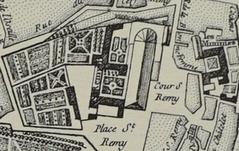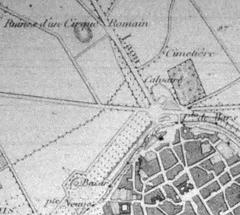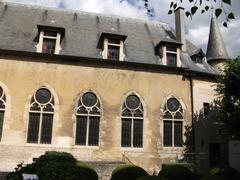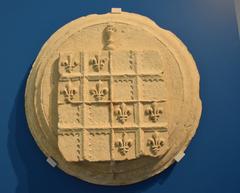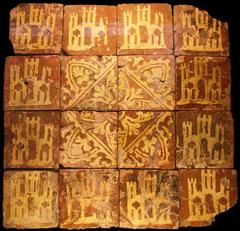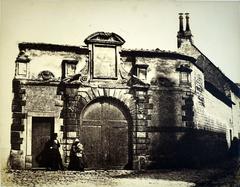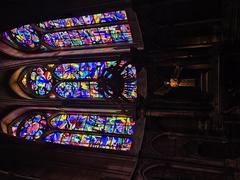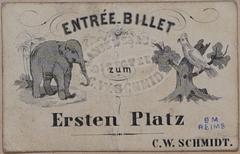
Basilica of Saint-Remi Visiting Hours, Tickets, and Historical Significance in Reims, France
Date: 14/06/2025
Introduction
The Basilica of Saint-Remi in Reims stands as a profound symbol of France’s religious, cultural, and architectural heritage. Famed for its association with the baptism of Clovis I by Saint Remigius in 496 AD, the basilica marks a pivotal turning point in French history, signifying the Christianization of the Frankish kingdom and establishing Reims as a spiritual center (History Hit; francerent.com). Its blend of Romanesque and Gothic styles, spiritual legacy, and ongoing community role make it a must-visit for history enthusiasts, pilgrims, and travelers alike.
Contents
- Introduction
- Historical Overview and Architectural Evolution
- Architectural Highlights and Artistic Features
- Visitor Information (Hours, Tickets, Accessibility, Tours)
- Cultural and Religious Significance
- Preservation and UNESCO Status
- Frequently Asked Questions (FAQ)
- Plan Your Visit
- Summary and Recommendations
- Sources and Further Reading
Historical Overview and Architectural Evolution
Early Foundations
The basilica’s origins trace back to the 6th century, where it was built over the tomb of Saint Remigius. This site became a center for pilgrimage, especially after the baptism of Clovis I, which signified the beginning of Christian France (History Hit; Wikipedia). In the 11th century, the current basilica was constructed to house the saint’s relics and accommodate the increasing number of pilgrims.
Romanesque Beginnings (11th Century)
The initial structure, built between 1005 and 1049, is the largest Romanesque church in northern France, featuring thick walls, rounded arches, and massive pillars. Its scale (nave measuring 126 meters) reflects its importance as a pilgrimage site (Eupedia; France Voyage).
Gothic Transformations (12th–13th Centuries)
Later expansions introduced pointed arches, ribbed vaults, and larger stained glass windows, particularly in the choir and ambulatory, creating a striking interplay between Romanesque solidity and Gothic lightness (Reims Tourisme).
Subsequent Additions and Restorations
The 15th-century south transept façade showcases late Gothic elements, while the adjacent abbey buildings were rebuilt in the 17th and 18th centuries. The basilica suffered significant damage during the French Revolution and World War I but has been meticulously restored (Spotting History).
UNESCO World Heritage Status
Recognized as a Monument Historique in 1840 and inscribed as a UNESCO World Heritage Site in 1991, the basilica is celebrated for its universal value and preservation (UNESCO).
Architectural Highlights and Artistic Features
- Nave and Transepts: The Romanesque nave features robust arcades and columns, while the upper transepts reflect Gothic innovations (Eupedia).
- Choir and Ambulatory: The Gothic choir with radiating chapels facilitates pilgrim movement (Reims Tourisme).
- Stained Glass: Windows from the 12th to 15th centuries display biblical scenes and vibrant colors (Spotting History).
- Tomb of Saint Remigius: The choir houses the saint’s ornate golden sarcophagus, surrounded by sculptures of clerical and noble figures (Travel to Eat).
- The Grand Organ: The Cattiaux organ, installed in 2000, continues the basilica’s musical heritage (Reims Tourisme).
- Abbey Complex: The adjacent former abbey houses the Musée Saint-Remi, with collections from the Gallo-Roman era to the Renaissance (Voyage Tips).
Visitor Information
Visiting Hours
- Typically open daily from 9:00/9:30 AM to 6:00 PM.
- Last entry is 30 minutes before closing.
- Closed on January 1st, May 1st, and December 25th.
- Confirm hours on the official basilica website or Reims Tourism.
Tickets and Admission
- Entry to the basilica is free.
- Guided tours are available for a fee (approx. €9/adult; free with Reims Epernay Pass).
- The adjacent Saint-Remi Museum has a separate entrance fee (approx. €3; free with city pass).
- Guided tours and audio guides can be booked online or on-site.
Accessibility
- The basilica is wheelchair accessible via ramps at main entrances.
- Most areas have level flooring; some historic sections may have limited access.
- Staff assistance is available upon request.
Guided Tours and Events
- Regular guided tours in multiple languages offer deep insights into the basilica’s history and art.
- The basilica hosts concerts, religious festivals, and special events such as the annual Saint Remi Celebration and summer light shows (Catholique Reims; Reims Tourism).
Getting There
- Address: Place Chanoine Ladame, 51100 Reims, France.
- Easily reached by foot (20 minutes from city center), local bus, or taxi.
- Reims is accessible from Paris by TGV train in about 45 minutes.
Facilities
- Restrooms and tourist information are available on-site.
- Luggage storage options are provided nearby by services like Nannybag (Nannybag).
Nearby Attractions
- Notre-Dame Cathedral: Another UNESCO World Heritage Site, a short walk away.
- Palace of Tau: Former archbishop’s residence and museum.
- Musée Saint-Remi: Extensive regional history exhibits in the former abbey (Voyage Tips).
Cultural and Religious Significance
The Basilica of Saint-Remi remains a spiritual heart of Reims. It is the final resting place of Saint Remigius, whose role in baptizing Clovis I initiated France’s Christian era (francerent.com). The basilica also safeguarded the Holy Ampulla, the sacred oil used in French royal coronations, further cementing its national symbolism (champagne-patrimoinemondial.org).
Annual religious festivals, processions, and the cult of Saint Remi draw pilgrims and visitors from across France and Europe, maintaining a dynamic tradition of faith and community engagement. The basilica’s designation as a UNESCO site underlines its outstanding universal value as a monument of history, spirituality, and art (UNESCO).
Preservation and Restoration
Damaged during the French Revolution and World War I, the basilica underwent decades of careful restoration, led by architect Henri Deneux, to preserve its Romanesque and Gothic integrity (Isolated Traveller). Today, ongoing conservation efforts ensure that the basilica remains a vibrant living heritage site, open to worship, culture, and education.
Frequently Asked Questions (FAQ)
Q: What are the Basilica of Saint-Remi visiting hours?
A: Generally 9:00/9:30 AM to 6:00 PM daily, with seasonal variations. Check official sources for updates.
Q: Is there an entrance fee?
A: Entry to the basilica is free; museum and guided tour tickets are available separately.
Q: Are guided tours available?
A: Yes, in multiple languages. Booking is recommended, especially in high season.
Q: Is the basilica accessible for visitors with disabilities?
A: Yes, with ramps and level access in most areas.
Q: Can I take photos inside?
A: Photography is generally permitted, but flash and tripods may be restricted.
Q: How do I reach the basilica from Paris?
A: Take the TGV train to Reims (about 45 minutes), then a bus or 20-minute walk to the basilica.
Plan Your Visit
- Dress code: Modest attire is suggested, especially during services.
- Languages: Information and tours available in French and English, with additional languages possible.
- Contact: For inquiries, email [email protected] or call 03 26 85 31 20.
- Digital Resources: Download the Audiala app for guided audio tours and real-time updates.
For a comprehensive experience, combine your visit with other UNESCO sites in Reims, such as the Notre-Dame Cathedral and the Palace of Tau. Explore the Musée Saint-Remi for deeper historical context and enjoy special events or concerts for a unique perspective on this architectural jewel.
Summary and Recommendations
The Basilica of Saint-Remi is a cornerstone of French history and spirituality. Its architectural grandeur, spiritual legacy, and vibrant community life make it an essential destination in Reims. With free entry, accessibility, guided tours, and proximity to other major sites, it offers a rich and multifaceted visitor experience. Leverage official resources, digital guides, and city passes to optimize your visit and fully immerse yourself in Reims’ cultural heritage.
Sources and Further Reading
- History Hit: Saint-Remi Abbey
- France Rent: Basilique Saint-Remi
- Isolated Traveller: Abbey of Saint-Remi Basilica
- Reims Tourism: Top 10 Attractions
- Catholique Reims: Basilica of Saint-Remi de Reims
- Champagne Patrimoine Mondial
- UNESCO World Heritage Centre

